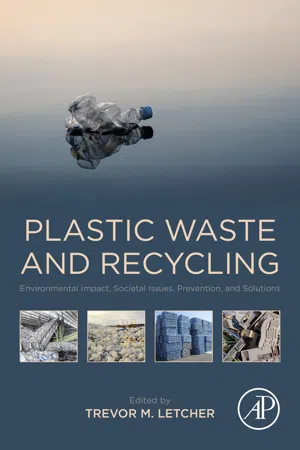
Plastic Waste and Recycling
Environmental Impact, Societal Issues, Prevention, and Solutions
- 686 pages
- English
- ePUB (mobile friendly)
- Available on iOS & Android
Plastic Waste and Recycling
Environmental Impact, Societal Issues, Prevention, and Solutions
About this book
Plastic Waste and Recycling: Environmental Impact, Societal Issues, Prevention, and Solutions begins with an introduction to the different types of plastic materials, their uses, and the concepts of reduce, reuse and recycle before examining plastic types, chemistry and degradation patterns that are organized by non-degradable plastic, degradable and biodegradable plastics, biopolymers and bioplastics. Other sections cover current challenges relating to plastic waste, explain the sources of waste and their routes into the environment, and provide systematic coverage of plastic waste treatment methods, including mechanical processing, monomerization, blast furnace feedstocks, gasification, thermal recycling, and conversion to fuel.This is an essential guide for anyone involved in plastic waste or recycling, including researchers and advanced students across plastics engineering, polymer science, polymer chemistry, environmental science, and sustainable materials.- Presents actionable solutions for reducing plastic waste, with a focus on the concepts of collection, re-use, recycling and replacement- Considers major societal and environmental issues, providing the reader with a broader understanding and supporting effective implementation- Includes detailed case studies from across the globe, offering unique insights into different solutions and approaches
Frequently asked questions
- Essential is ideal for learners and professionals who enjoy exploring a wide range of subjects. Access the Essential Library with 800,000+ trusted titles and best-sellers across business, personal growth, and the humanities. Includes unlimited reading time and Standard Read Aloud voice.
- Complete: Perfect for advanced learners and researchers needing full, unrestricted access. Unlock 1.4M+ books across hundreds of subjects, including academic and specialized titles. The Complete Plan also includes advanced features like Premium Read Aloud and Research Assistant.
Please note we cannot support devices running on iOS 13 and Android 7 or earlier. Learn more about using the app.
Information
Chapter 1: Introduction to plastic waste and recycling
Abstract
Keywords
1.1. Introduction
1.2. Our dependence on things plastic
- • computers, smart phones, and electronic equipment that are all dependent on plastic for their frames and housing,
- • insulation for our houses,
- • textiles and clothing,
- • fresher products wrapped in plastic and from all over the world in our supermarkets,
- • plastic syringes and tubing that have revolutionized medicine,
- • plastic bags and pots that, in turn, have revolutionized farming and horticulture,
- • toys, two-thirds of all toys are made of plastic and most are played with for a few minutes and discarded,
- • a vehicular industry that is totally dependent on plastic for dashboards, seat covers, interior surfaces, electric insulation, and bumpers,
- • water pipes and conduit piping for gas, electricity, and telephone cables, to name a few.
- Many of the plastic items are used only once and then discarded—plastic bags, coffee and beverage cups, toys, cutlery, drinking straws, and wet wipes, etc.
- “Give-away” toys handed out as incentives at food outlets and retail shops are becoming a real problem for landfill operators as the mountains of unwanted plastic toys mount up. In most cases, the many millions of these toys produced annually are played with for only a few minutes before being discarded. It has been estimated that two-thirds of all toys are made of plastic.
1.3. Recycling
Table of contents
- Cover image
- Title page
- Table of Contents
- Copyright
- Dedication
- Contributors
- Preface
- Part 1. Introduction
- Part 2. Innovation in plastic materials
- Part 3. End of life problems for plastic waste
- Part 4. Solutions for plastic waste
- Part 5. Plastics: society and the environment
- Part 6. Plastic waste around the world
- Index